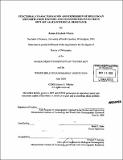Functional characterization and expression of molluscan detoxification enzymes and transporters involved in dietary allelochemical resistance
Author(s)
Whalen, Kristen Elizabeth
DownloadFull printable version (51.79Mb)
Other Contributors
Woods Hole Oceanographic Institution.
Advisor
Mark E. Hahn.
Terms of use
Metadata
Show full item recordAbstract
Understanding how organisms deal with potentially toxic or fitness-reducing allelochemicals is important for understanding patterns of predation and herbivory in the marine environment. The ability of marine consumers to tolerate dietary toxins may involve biochemical resistance mechanisms, which increase the hydrophilicity of compounds and facilitate their active efflux out of sensitive cells and tissues. While several allelochemical-responsive detoxification enzymes have been sequenced and functionally characterized in terrestrial invertebrates feeding on chemically defended host plants, there is virtually no information concerning the role of these biotransformation enzymes that may mediate feeding tolerance in marine invertebrates. The objective of this research was to assess the diversity and dietary regulation of cytochrome P450s (CYP), glutathione S-transferases (GST) and ABC transporters in the generalist marine gastropod Cyphoma gibbosum feeding on a variety of chemically defended gorgonian corals, and to identify those dietary natural products that act as substrates for these proteins. Molecular and proteomic techniques identified both allelochemically-responsive CYPs, and constitutively expressed GSTs and transporters in Cyphoma digestive glands. Inhibition of Cyphoma GST activity by gorgonian extracts and selected allelochemicals (i.e., prostaglandins) indicated that gorgonian diets are likely to contain substrates for molluscan detoxification enzymes. In vitro metabolism studies with recombinant CYPs suggested those Cyphoma enzymes most closely related to vertebrate fatty acid hydroxylating enzymes may contribute to the detoxification ofichthyodeterrent cyclopentenone prostaglandins found in abundance in selected gorgonian species. (cont.) Finally, the presence and activity of multixenobiotic resistance transporters in Cyphoma and the co-occurring specialist nudibranch, Tritonia hamnerorum, suggests these efflux transporters could function as a first line of defense against dietary intoxication. Together, these results suggest marine consumers that regularly exploit allelochemical-rich prey have evolved both general (GST and ABC transporters) and allelochemical-specific (CYP) detoxification mechanisms to tolerate prey chemical defenses.
Description
Thesis (Ph. D.)--Joint Program in Oceanography/Applied Ocean Science and Engineering (Massachusetts Institute of Technology, Dept. of Biology; and the Woods Hole Oceanographic Institution), 2008. Page 362 blank. Includes bibliographical references.
Date issued
2008Department
Joint Program in Oceanography/Applied Ocean Science and Engineering; Woods Hole Oceanographic Institution; Massachusetts Institute of Technology. Department of BiologyPublisher
Massachusetts Institute of Technology
Keywords
/Woods Hole Oceanographic Institution. Joint Program in Oceanography/Applied Ocean Science and Engineering., Biology., Woods Hole Oceanographic Institution.